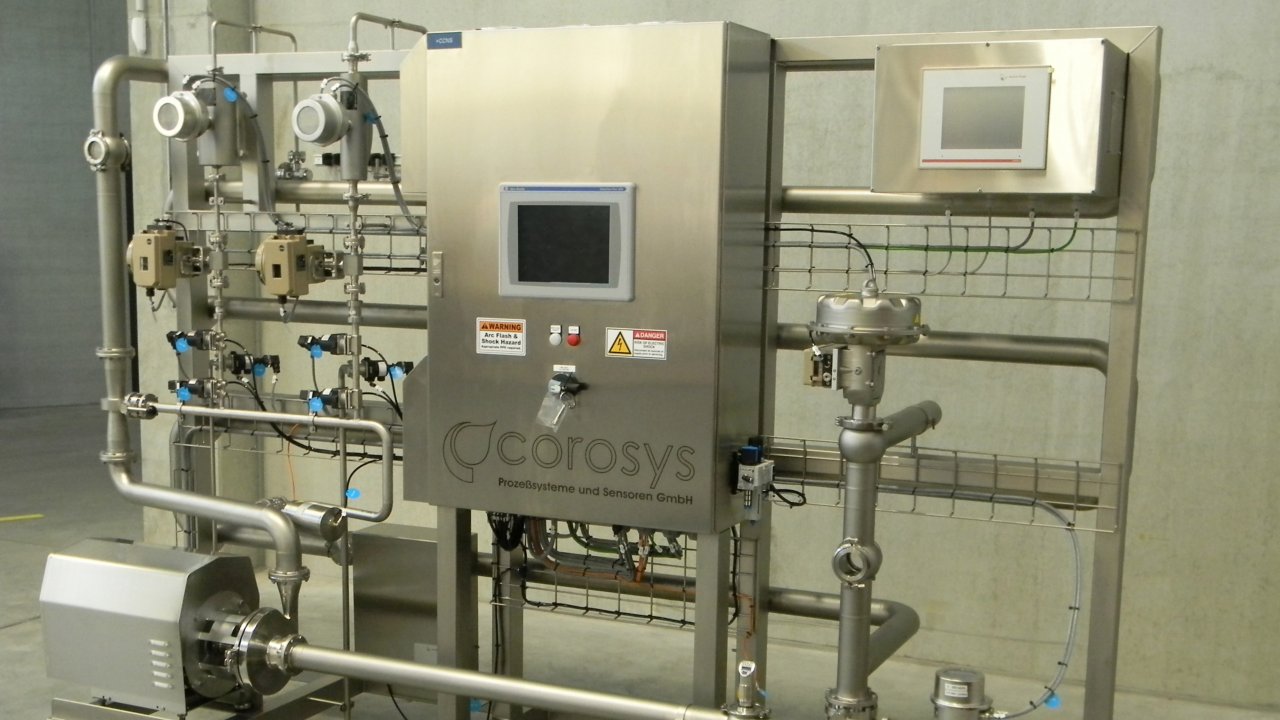Solution
One machine to benefit from the new solution is the company’s Carbonation System (CCS), which continuously and highly accurately controls the CO2 content of beer, beer mix drinks, soft drinks and mineral water by precisely regulated dosing of CO2. The process is well established in the brewing and soft drink industry for the production of carbonated beverages and can be installed between beer filtration and the bright beer tank (BBT) as well as directly before the filler. A blending system or a premixer can also be combined with the unit. The system is characterised by highly accurate and reliable analysers and precise control algorithms.
Stefan Feider, Head of Automation at corosys explains the process: “The US market has a lot of manual filters and our idea was to engineer a carbonation system to carbonate beer to a very accurate value, without the need for a buffer tank. Normally you need a buffer prior to carbonation and then a filler tank afterwards. With our unit, running on the Allen-Bradley hardware and Rockwell Software® solution, we can run without a buffer tank. It is also a very small unit compared to other solutions. And with many of our customers having real estate at a premium, the compactness of the Allen-Bradley CompactLogix™ programmable automation controller (PAC) suited the small cabinet size, while still delivering the performance we needed.”
In operation, CO2 is injected into the beer via a GDI gas injector developed by corosys. The gas injector splits the CO2 into very small bubbles to ensure that the CO2 completely dissolves in a very short time. The homogeneous dispersion and the absence of gas bubbles can be monitored using a sight glass situated at the outlet of the dissolving path and the CO2 content is continuously measured in-line at the outlet of the unit. The productspecific set point is compared with the process value and the CO2 flow is adjusted accordingly using a control algorithm. The control valve, which is located at the end of the dissolving path, keeps the pressure in the system constant, even if the flow is unsteady.
“We measure the CO2 content at the end using a sample system.” Feider explains, “The CompactLogix PAC is used to calculate the levels using advanced algorithms and then changes the flow to adjust it to reflect the optimum mix. The PAC looks at the input and the output, so the levels do not have to be retrospectively adjusted. This approach means that there is no need for a buffer tank as the flow is adjusted inline.”
In addition to the CompactLogix PAC, the machine also deploys an Allen-Bradley PanelView™ HMI to provide operator interactions, Allen-Bradley PowerFlex® 525 and 755 variable-speed drives to control the pumps, and a number of I/O modules for data capture and sensor inputs. By deploying an EtherNet/IP™ based network infrastructure, the machine can also be controlled by a wider process control system.
By using EtherNet/IP as the primary communication protocol, corosys has given itself the opportunity to more easily offer its customers remote monitoring and maintenance, while also having the option to connect the machine into its customers’ Connected Enterprise. The Connected Enterprise®, an approach manufacturers are adopting to leverage the use of connected machines, supply chains and customers, allows them to establish manufacturing processes that are data / information rich, supported, secure and future ready for market demands.
Ultimately, a Connected Enterprise approach for manufacturers and their suppliers such as corosys, will create a more competitive, innovative enterprise that can deliver insights to improve productivity, sustainability and economic performance through faster time to market, lower total cost of ownership, improved asset utilisation and enterprise risk management. Other benefits of access to real-time, contextualised information, include minimised downtime, improved technology and process optimisation, greater workforce efficiency and smarter expenditure. Because EtherNet/IP is based on standard, unmodified Ethernet, it means that there is very little that needs to be done for these connections to be established; and full security solutions are also available for user control and to prevent unwarranted access.

